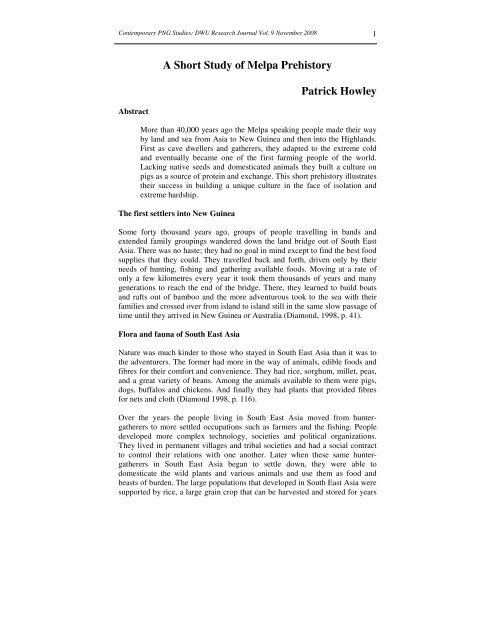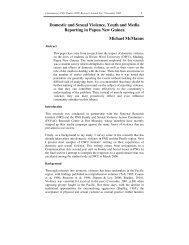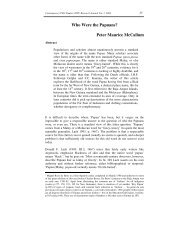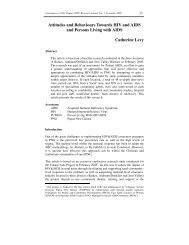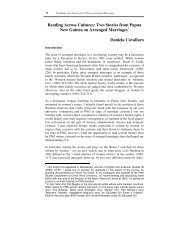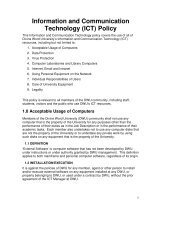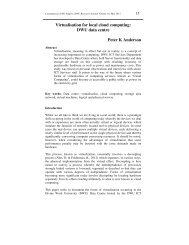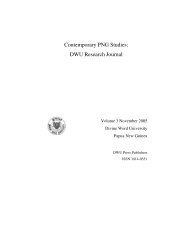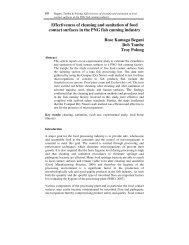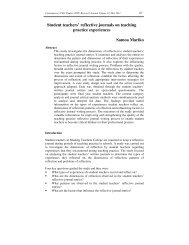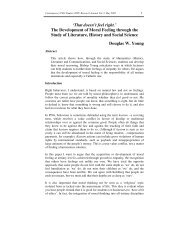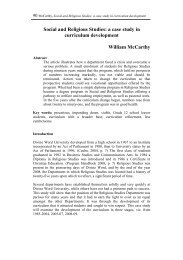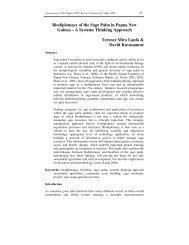A short study of Melpa rehistory - Divine Word University
A short study of Melpa rehistory - Divine Word University
A short study of Melpa rehistory - Divine Word University
- No tags were found...
You also want an ePaper? Increase the reach of your titles
YUMPU automatically turns print PDFs into web optimized ePapers that Google loves.
Contemporary PNG Studies: DWU Research Journal Vol. 9 November 2008 1AbstractA Short Study <strong>of</strong> <strong>Melpa</strong> P<strong>rehistory</strong>Patrick HowleyMore than 40,000 years ago the <strong>Melpa</strong> speaking people made their wayby land and sea from Asia to New Guinea and then into the Highlands.First as cave dwellers and gatherers, they adapted to the extreme coldand eventually became one <strong>of</strong> the first farming people <strong>of</strong> the world.Lacking native seeds and domesticated animals they built a culture onpigs as a source <strong>of</strong> protein and exchange. This <strong>short</strong> p<strong>rehistory</strong> illustratestheir success in building a unique culture in the face <strong>of</strong> isolation andextreme hardship.The first settlers into New GuineaSome forty thousand years ago, groups <strong>of</strong> people travelling in bands andextended family groupings wandered down the land bridge out <strong>of</strong> South EastAsia. There was no haste; they had no goal in mind except to find the best foodsupplies that they could. They travelled back and forth, driven only by theirneeds <strong>of</strong> hunting, fishing and gathering available foods. Moving at a rate <strong>of</strong>only a few kilometres every year it took them thousands <strong>of</strong> years and manygenerations to reach the end <strong>of</strong> the bridge. There, they learned to build boatsand rafts out <strong>of</strong> bamboo and the more adventurous took to the sea with theirfamilies and crossed over from island to island still in the same slow passage <strong>of</strong>time until they arrived in New Guinea or Australia (Diamond, 1998, p. 41).Flora and fauna <strong>of</strong> South East AsiaNature was much kinder to those who stayed in South East Asia than it was tothe adventurers. The former had more in the way <strong>of</strong> animals, edible foods andfibres for their comfort and convenience. They had rice, sorghum, millet, peas,and a great variety <strong>of</strong> beans. Among the animals available to them were pigs,dogs, buffalos and chickens. And finally they had plants that provided fibresfor nets and cloth (Diamond 1998, p. 116).Over the years the people living in South East Asia moved from huntergatherersto more settled occupations such as farmers and the fishing. Peopledeveloped more complex technology, societies and political organizations.They lived in permanent villages and tribal societies and had a social contractto control their relations with one another. Later when these same huntergatherersin South East Asia began to settle down, they were able todomesticate the wild plants and various animals and use them as food andbeasts <strong>of</strong> burden. The large populations that developed in South East Asia weresupported by rice, a large grain crop that can be harvested and stored for years
Contemporary PNG Studies: DWU Research Journal Vol. 9 November 2008 3band is an extended family or several related extended families. The next level<strong>of</strong> tribal organization has, as its basic constitution, the social contract. It forbidsmurder, adultery, stealing and lying and requires care for the young and old andexists for the security <strong>of</strong> all members <strong>of</strong> the tribe (not outsiders). The socialcontract did not extend the same rights and privileges to other tribes, most <strong>of</strong>whom were regarded as enemies.Good relationships and unity were essential to any such small group for itssecurity against enemy tribes. Leaders enforced the social contract, not because<strong>of</strong> its moral values, but because divisions in the community caused weaknessesand laid the community open to enemy attacks. All the members <strong>of</strong> the tribefrom the oldest to the youngest had a network <strong>of</strong> relationships with all the othermembers <strong>of</strong> the tribe which was maintained by reciprocal gift giving <strong>of</strong> foodand services. This practice is universal in all small tribal groups. 2Tribal existence is exemplified by New Guinea highlanders, whose politicalunit before the arrival <strong>of</strong> colonial government was a close-knit cluster <strong>of</strong>scattered settlements. They shared the same language and land. They wereruled by a big-man who was not a chief (Diamond, 1998, p.269). A chief hascoercive powers but a big-man is one who rules with the consent <strong>of</strong> hisfollowers, who, if they were dissatisfied could desert him or apply othersanctions to force him to meet their needs. Prowess as a warrior may have beenthe way <strong>of</strong> some big-men, but normally the big-man was a charismatic figure,able to attract followers by his superior ability to satisfy the needs <strong>of</strong> his peopleand control them by his personality and power. All big-men had commonfeatures in their approach to government but each group developed its ownstyle and customs to suit its own culture. Many were aggressive and maledominant; all had skills as negotiators, entrepreneurs, arbiters <strong>of</strong> conflicts andnetworkers with other tribes and clans.First agriculture in the worldThe first organised agriculture in the world developed independently at aroundthe same time, in the Fertile Crescent, China, America and the Indus valleyduring the years when the last major ice age was declining about 12,000 yearsBP.The <strong>Melpa</strong> speaking people - agriculture at Kuk swamp2 All these studies contain the idea that exchange, as a system <strong>of</strong> meanings, is involvedin the shaping or construction <strong>of</strong> particular cultural realities. They do this by focusing onthe act <strong>of</strong> presentation as a rhetorical gesture in social communication, stressing thesymbolism <strong>of</strong> the objects exchanged and viewing transactions as expressive statementsor movements in the management <strong>of</strong> meaning. Through the management <strong>of</strong> meaningexchange becomes a vehicle <strong>of</strong> social obligation and political manoeuvre....and in a largersense social reciprocity may be analysed to reveal its embeddedness in their structure <strong>of</strong>cultural thought, and how it symbolically contributes to the social construction <strong>of</strong> reality(Schieffelin, 1980, p.503).
4Howley, A Short Study <strong>of</strong> <strong>Melpa</strong> P<strong>rehistory</strong>About 9,000 years BP the <strong>Melpa</strong> speakers, who are the focus <strong>of</strong> this <strong>study</strong>,began gardening in the 180m 2 <strong>of</strong> swamp land at Kuk on the upper Wahgivalley floor (Golson & Gardner, 1990, p.397). The Kuk settlement based onbananas and taro was unique. In all other early agricultural settlements in theworld, the base crop was grain – wheat, barley, corn – but in Kuk, it wasbananas (known as australimusa bananas), taro, rubus, coleus, pouzolzia,wahlenbergia, grass stems, roots, pitpit (Saccharurnedule), green vegetablesand the nut tree canarium indicum (Bulmer, 1964, p.45). New Guinea has nolarge native grass grains so the most likely reason for the failure <strong>of</strong> cerealagriculture to arise in New Guinea is a glaring deficiency <strong>of</strong> the wild startingmaterial. Not one <strong>of</strong> the world's 56 largest-seeded wild grasses is native here(Diamond, 1998, p.148).Figure 1. Map showing location <strong>of</strong> Mount HagenWilliams, the Papuan government anthropologist, wrote:There may be, according to Fr Ross' rough estimate, 25,000natives speaking various dialects <strong>of</strong> the Mt Hagen language.They are divided into some 20 tribes, Mogei, Kobei, Jika,Yauka, etc.; and these again into many more numerous localgroups. All <strong>of</strong> their members share an origin myth providingthem with a dogma <strong>of</strong> common ancestry and with a singledivination-substance. In the northern part <strong>of</strong> the <strong>Melpa</strong> area,we are able to identify the clan territory-holding, alliancemakinggroup, important in past warfare and presentceremonial exchanges (Williams, 1937, p.90).The groups had importance in that they could identify a person as a friend or anenemy for there was an unspoken law that tribal fighting did not occur withinthe group.
Contemporary PNG Studies: DWU Research Journal Vol. 9 November 2008 5Domesticated animals: pigs, dogs, chickensThe people still had no domesticated animals and it was not until about 5,000years BP that the pig was imported (Golson & Gardner, 1990, p.406) and laterchickens and dogs arrived from South East Asia by way <strong>of</strong> Indonesia and theAustronesian people who settled in New Guinea about 3,500 BP (Diamond1998:304). Alongside the Kuk gardeners, the people still continued theirhunting for protein and gathering as they did in the rest <strong>of</strong> the highlands, but atKuk there was a genuine settlement which required a change in relationshipsthat the villagers had with one another. It provided a model <strong>of</strong> what was tocome.Agriculture in the dry landsThe importance <strong>of</strong> Kuk was that it was the first experiment in agriculture inNew Guinea and among the first in the world. But Kuk was not the onlyfarming experiment in the upper Wahgi. The <strong>Melpa</strong> were growing taro on thedry lands in the upper Wahgi 2,500 years ago (Golson & Gardner, 1990,p.399). Recent experiments by Bayliss Smith show that taro crops grown inwetland swamp are more productive than on the grasslands but not remarkablyso 3 . However, they are still sufficient to serve a good sized farming population(Golson & Gardner, 1990, p.400). In other words gardening taro was providingfor a well established population.Protein deficiencyNone the less, until better foods were imported, the New Guinea highlandpopulations suffered from severe protein deficiency. The staple food, taro,consists <strong>of</strong> only 1% protein, much worse even than white rice, and far belowthe levels <strong>of</strong> the wheat and pulses grown in the Fertile Crescent which had 8-14% and 20-25% protein, respectively (Diamond, 1998, p.149). Children withswollen bellies were characteristic <strong>of</strong> the high-bulk protein-deficient diet andthe whole population, old and young routinely ate mice, spiders, frogs andother small animals that people elsewhere with access to domestic mammals orlarge wild game species do not bother to eat (Diamond, 1998, p.149).Pig farming at KukAs the hunters killed <strong>of</strong>f the local animals, they had to move further afield todo their hunting. Thus pigs were domesticated to replace wild animals as asource <strong>of</strong> protein. This began a gradual change as the domesticated pig becamea source <strong>of</strong> wealth in barter, ceremonies, local exchange networks and regionaltrade in a wide variety <strong>of</strong> goods, which included plumes, salt, tree oils, stoneaxes and shells (Golson & Gardner, 1990, p.398).3 Bayliss Smith reported annual taro yields <strong>of</strong> 12-25 gross tonnes per hectare for four sites<strong>of</strong> wetland cultivation between 1500m and 1640m and <strong>of</strong> 8-10 tonnes per hectare for tarogrown under swidden in three societies <strong>of</strong> the Highlands fringe between 1200m and1900m.
6Howley, A Short Study <strong>of</strong> <strong>Melpa</strong> P<strong>rehistory</strong>Developing cultural changesAlready the <strong>Melpa</strong> <strong>of</strong> the upper Wahgi had begun to develop political andsocial structures that later became the trademark <strong>of</strong> highland politics, customand culture (Golson and Gardner, 1990, p.398). However, considering theunreliable nature <strong>of</strong> taro farming in both the grasslands and the swamps therewere insufficient regular food supplies to support the social and politicalstructures that developed later.Introduction <strong>of</strong> the sweet potato (Ipomoea batatas)The sweet potato (Ipomoea batatas) is a native <strong>of</strong> South America. It wasintroduced to New Guinea about 300 years ago, probably by Indonesian sailors,who at that time were making regular expeditions to the north coast <strong>of</strong> NewGuinea to purchase bird <strong>of</strong> paradise plumes, beche de mer and trochus shells. 4The first evidence <strong>of</strong> the presence <strong>of</strong> sweet potato in New Guinea is somecharred fragments at Kuk swamp dated 250 BP (Fiel, 1986, p.630).Superiority <strong>of</strong> the sweet potatoIn the swamps <strong>of</strong> Kuk, sweet potato did not produce spectacular results whencompared with the taro which was the previous dominant crop, but in the drylands, forest soils and agriculturally depleted and poorer soils in the grasslands,it grows more quickly and gives much higher yields per hour <strong>of</strong> labour. Itgrows well at high altitudes and so made new agricultural areas available topeople in the higher mountains and is by far the most important crop at allaltitudes between 1600m and 2800m (Brookfield, 1991, p.206). Its greatestimportance was that as a staple crop, the sweet potato crop allowed for politicaland cultural processes that had existed in an underdeveloped state before thisperiod.Changes resulting from the sweet potato in the upper WahgiThe most obvious outward result <strong>of</strong> the arrival <strong>of</strong> the sweet potato is seen todayin the upper Wahgi 250 years after it was introduced. When Europeans firstflew over the highlands in the 1930s, they were astonished to see below them alandscape similar to Holland. Broad valleys were completely deforested anddotted with villages, and drained and fenced fields for intensive foodproduction covered entire valley floors. That landscape testifies to thepopulation densities achieved in the highlands by farmers with stone tools(Diamond, 1998, p.304).4 Others suggest that it may have been introduced from the Philippines by Spanishexplorers.
Contemporary PNG Studies: DWU Research Journal Vol. 9 November 2008 7The importance <strong>of</strong> the pigChanges which had begun during the years <strong>of</strong> taro farming in the forest andgrasslands, were now given an impetus because the sweet potato is a matchlessfood for pigs (Golson & Gardner 1990:398). Pigs are not fond <strong>of</strong> uncookedtaro. They enjoyed the worms available in the moist soils <strong>of</strong> Kuk (Golson &Gardner, 1990, p.406) but this was not enough to develop large herds <strong>of</strong> pigs.The arrival <strong>of</strong> the sweet potato changed this to an unexpected degree. Pigs atethe sweet potato raw and thrived on it.Even though the sweet potato like the taro is low in protein (Diamond, 1998,p.149), it became a major source <strong>of</strong> protein in the form <strong>of</strong> pork. As a pig food,the sweet potato is superior to the existing crops, and so was irresistible to pigcenteredsocieties. All the people now had a prime pig fodder that could also begrown over a wide range <strong>of</strong> soils and environments. Thus the sweet potatotheoretically enabled everybody to enter exchange systems (moka) previouslyinaccessible to anyone outside centres <strong>of</strong> high productivity for taro (Golson &Gardner, 1990, p.408).The pig - money on the ho<strong>of</strong>In countries with a grain economy, the stored grain had a financial value.Among the <strong>Melpa</strong> the same result was achieved through surplus pigs, using theavailable sweet potato supply as fodder for a sort <strong>of</strong> ‘storage on-the-ho<strong>of</strong>’ (Fiel,1986, p.631). Pigs became the currency for making alliances, exchange, sealingagreements, making peace, or bride wealth and funeral payments (Golson &Gardner, 1990, p.396). Pigs became the ‘essential coin’ for proliferatingtransactions <strong>of</strong> all kinds and in which politics and competition increased (Fiel,1986, p.631). The <strong>Melpa</strong>, a naturally competitive group, now had the means tojoin the race <strong>of</strong> outclassing each other. They now had a secure and abundantsource <strong>of</strong> protein and, as its value increased as an object <strong>of</strong> exchange, it becametoo expensive for regular consumption. Even today, most <strong>Melpa</strong> still view pigsin this way – ‘nice to eat, better and more valuable to exchange’.Big-man, control <strong>of</strong> ancestor spirits<strong>Melpa</strong> big-men traditionally played an important part in all ritual activitiesinvolving the co-operation <strong>of</strong> clansmen. They could call on their dead kinsfolkand their more remote ancestors to grant clansmen fertility, health and wealth,or on the contrary bring sterility, sickness and poverty on them by withdrawingsupport. Sickness in particular was <strong>of</strong>ten attributed to a moral misdemeanor.Payment <strong>of</strong> a pig might be sufficient to pay for the damage done (Strathern,1970, p.573).Big-man, control <strong>of</strong> cultsCults among the <strong>Melpa</strong> were initiated, planned by prominent big-men inpolitics and in entrepreneurial ventures. The cult which took place in stagesover the years required the sacrifice <strong>of</strong> large numbers <strong>of</strong> pigs. The holding <strong>of</strong> a
8Howley, A Short Study <strong>of</strong> <strong>Melpa</strong> P<strong>rehistory</strong>cult is, in fact, one way in which a big-man demonstrates his successfulentrepreneurship (Strathern, 1970, p.572).Big-man, control <strong>of</strong> shellsMarine shells worked as ornaments have been reported back to 9000 BP inexcavated rock-shelters in the Papua New Guinea Highlands (Golson &Gardner, 1990, p.408). Twelve species <strong>of</strong> shell were common but it was thegold lip pearl shell which had by far the greatest value for barter. The supplywas unreliable and subject to long term interruptions. As already mentioned, itwas the prerogative <strong>of</strong> the big-men to control the supplies <strong>of</strong> shells, axes,plumes and other goods, and they made every effort to protect their privileges.Shells were by far the most important as they were the essential token inmaking moka.Big-man, control <strong>of</strong> mokaWith the coming <strong>of</strong> the sweet potato anyone could grow sweet potato and raisepigs and so theoretically anyone could be a big-man. Thus it was necessary forthe powerful leaders who managed the politics <strong>of</strong> the clan to find means todemonstrate their superiority (Strathern, 1979, p.533).The moka had its origins in the reciprocal gift-giving process mentioned as apart <strong>of</strong> the social contract. Any gift required a return <strong>of</strong> a gift <strong>of</strong> equal orgreater value. Gifts <strong>of</strong> food could be repaid much later in services such ashouse building or support in some other venture. This fitted neatly into theexciting ceremonies and exchanges <strong>of</strong> the moka.‘Making moka’ entails repaying a gift-debt, not just with an equivalent return,but with a value culturally defined as more than what the initial gift was worth.<strong>Melpa</strong> construe moka exchanges to balance in the long term; they are in whatStrathern terms an ‘alternating disequilibrium’ (Ledeman, 1990, p.8). Themoka, like ‘the Tee (in Enga), flowed on a path no bigger than a single strand<strong>of</strong> a spider's web; all care must be taken not to break it’ (Wisner, 1998, p.163).The ‘moka’ was an artificial and symbolic exchange <strong>of</strong> shells and othervaluables which depended on an exchange for other valuables, especially pigs,and in the final analysis on pig production and the ability <strong>of</strong> men to bargain intheir own favour. In actual shell-moka the starting mechanism was always asolicitory gift which included a pig, as well as two shells, in return for whicheight or ten shells would be expected in moka. Pigs had to be reared at home,and the major input <strong>of</strong> work here came from women (Strathern, 1975, p.535-536).Ordinary people became involved by working directly for the big-men in thehope <strong>of</strong> returns <strong>of</strong> wealth in the form <strong>of</strong> pearl shells for assistance in brideprice. The big-men did not necessarily ‘own the wealth’ so much as ‘control’ it.This was the essential skill <strong>of</strong> the <strong>Melpa</strong> big-man. It was a competition betweenpartners and groups to give back more than one has received. To put it in its
Contemporary PNG Studies: DWU Research Journal Vol. 9 November 2008 9most crude form, it was a process to exploit others, to control more completelythe means <strong>of</strong> producing vital exchange items, and to create a system <strong>of</strong> rankthat was justified by the argument that only men <strong>of</strong> wealth and ability werecapable to lead the clan and provide for its security.<strong>Melpa</strong> terms for valuing peopleAs a result <strong>of</strong> the fierce competition for status among the <strong>Melpa</strong> theredeveloped a whole vocabulary <strong>of</strong> terms to designate people according to theirstatus, power, usefulness in the moka and their relation to the community andthe hopes <strong>of</strong> the leaders. Strauss, Ross and Vicedom, (all European pioneers inHagen) reported on the variety <strong>of</strong> terms to describe the various members <strong>of</strong> thecommunity. With a cultural Western bias they first thought that these weretitles <strong>of</strong> nobility, but later they found that they served an entirely differentpurpose.There was a term indicating a ‘good at’ ability – having a certain skill or abilitywith no indication <strong>of</strong> moral value. To balance that there was another termwhich could be translated as ‘bad at’, an indication <strong>of</strong> a lack <strong>of</strong> effectiveability. Another term referred to those who assisted the big-men in economicventures and organisations and yet another referred to the man who did notamass wealth but gained status by passing it through his hands. Wo wagen(childless) was a pejorative term applied to one who was incapable, debilitatedand lacking in power while wo waglom is a term <strong>of</strong> appreciation for anappreciated kinsman. Strathern believed that these classes were developed notas an aristocracy but as categories which the big-men could utilise to increasetheir own power by manipulation and extraction <strong>of</strong> labour and support. There islittle doubt that the label could be used as a tag to indicate suitability forexploitation (Strathern, 1985, p.251).<strong>Melpa</strong> display <strong>of</strong> status and wealthSacred stones: Another gaming chip in the status competition was theownership <strong>of</strong> sacred stones. Vicedom noted that the leading men in clans werethose who possessed sacred stones in the Female Spirit cult celebrations.‘Each member <strong>of</strong> wu nuim class, including women andchildren, owns a stone, and in one tribe with a total population<strong>of</strong> 1500 persons there are 206 stone-owners and approximately50 adult male members <strong>of</strong> the ... cult group’ (Strathern, 1985,p.255).The Omak: Among the <strong>Melpa</strong> there was the constant competition among mento maintain their high pr<strong>of</strong>ile in the community. For some it was a simplematter <strong>of</strong> pretension, for others it was much more subtle. Chinnery in 1934described the ‘Omak’ as a row <strong>of</strong> <strong>short</strong> parallel bamboo sticks about fourinches long and a quarter <strong>of</strong> an inch in diameter, fastened together horizontallylike a miniature blind. It was worn on the breast and represented ownership <strong>of</strong>gold lip pearl shell, one shell for each stick (Chinnery, 1934, p.120). This was a
10Howley, A Short Study <strong>of</strong> <strong>Melpa</strong> P<strong>rehistory</strong>simple display <strong>of</strong> wealth and self importance, visible to all. A row <strong>of</strong> fiftysticks reaching to the waist would indicate the ownership <strong>of</strong> 50 gold lip pearlshells.<strong>Melpa</strong> gender relationshipsDiscrimination and violence against women have always been a part <strong>of</strong> thehuman condition. In all countries, societies and cultures, it is practised to agreater or lesser degree. Even religions and churches which give lip service tohuman rights and equality, continue to discriminate against women bothcovertly and overtly. It is with this background that we consider the genderrelationships among the <strong>Melpa</strong>.The development <strong>of</strong> pig herds had become a necessity for the big-man cultureand the management <strong>of</strong> the herds was an institutionalised exploitation <strong>of</strong>women. Women raised the pigs and so in a sense ‘owned’ them, but it was themen who carried on the exchange and gained the kudos by claiming their ownsuperiority in ownership <strong>of</strong> the means <strong>of</strong> production.The <strong>Melpa</strong> were an egalitarian society but in the game <strong>of</strong> pretension, wheremen, who were competing against other men, allowed each other a certainamount <strong>of</strong> inequality among themselves. But where women were concernedthey quickly closed ranks to declare collective superiority over women(Strathern, 1970, p.533). Some <strong>of</strong> the justification for the discrimination is tobe found in the belief that women endanger men by pollution. Wives bearchildren and thus bring life, but also can destroy men by infecting them withtheir menstrual blood (Strathern, 1970, p.583).Big-men staged a goddess cult ostensibly to promote the health <strong>of</strong> the clan andthe fertility <strong>of</strong> women and pigs. It would seem that the cult was introduced toovercome the problems <strong>of</strong> male-female relations which were corrupted by thesupposed contradiction between the life-giving and death-giving powers thatwomen possess (child-bearing against menstrual pollution) (Strathern, 1970,p.547). Possibly its real purpose was to strengthen male superiority and maledomination as was finally demonstrated by the hundreds <strong>of</strong> pigs slaughtered bythe men during the final feast (Brunton, 1965, p.125).The discrimination was most obvious in the control <strong>of</strong> the product. This wassomething that the men could not give up because it was at the very centre <strong>of</strong>their claim to status. It has been suggested the ritual cults did not implyantagonism between men and women but that they produced a kind <strong>of</strong>separation particularly in the tasks suited to the divisions <strong>of</strong> labour. As abalance to the discrimination, it is likely that women carried on a similarcompetition among themselves by glorying in the prestige <strong>of</strong> their husbands.Status in the reflected glory <strong>of</strong> a powerful and successful husband is apsychological factor in any community.
Contemporary PNG Studies: DWU Research Journal Vol. 9 November 2008 11In the final analysis the culture which defines discrimination and exploitationand what may appear exploitative to the outsider may be more <strong>of</strong> a mutualagreement among the members <strong>of</strong> the clan.Was the <strong>Melpa</strong> big-man system despotic?Some observers may view the manipulations <strong>of</strong> the big-men as despotic andexploitative or at least extractive. Certainly their particular skill was theirability to insert their authority into every phase <strong>of</strong> the life <strong>of</strong> the tribe. Theysettled land rights and land use; they were able to speak convincingly and withgood sense on any matter relating to the welfare <strong>of</strong> the tribe or clan, especiallyin making alliances, marriage settlements and going to war (Brandewe, 1971,p.208). However Brandewe after making a <strong>study</strong> <strong>of</strong> the Hagen big-man systemin 1971 wrote:The traditional system <strong>of</strong> leadership and administration in theHagen area has been very effective, given the values and thegoals the people have set for themselves. Their rule was byconsent and in this sense was as democratic as that in mostcountries with universal suffrage. His [big-man’s] influencewas limited to his own group or clan and the allies he mustbring together as a unit. Consequently, the big-man thinksfirst and foremost <strong>of</strong> his own lineage group and most othersoutside that group were generally considered as unfriendly(Brandewe, 1971, p.209).The more important question which still has no answer is in regard to thesuitability <strong>of</strong> big-man leadership to economic progress and the welfare <strong>of</strong> thepeople.InitiationHagen <strong>Melpa</strong> did not practice any <strong>of</strong>ficial initiation for their children. In thisthey were quite different from many other highland tribes. They believed thatchildren are made <strong>of</strong> a mixture <strong>of</strong> male semen and maternal blood in themother's womb. This being the case no ritual was needed to rid children <strong>of</strong>maternal blood, and there was no necessity for boys to be ‘broken’ from theirmother’s blood as in other tribes with initiation practices. However it was stillnecessary to make payment to maternal kin to ensure a child's health (Strathern,1970, p.375).From well before puberty boys began to sleep in the men's house rather thanthe women's house in their settlement and were attracted there with <strong>of</strong>fers <strong>of</strong>pork and other dainties by their male kin. Girls went with their mothers to thegardens; boys hunted and played in peer groups.In the highlands there was a strong emphasis on clan-hood. Especially amongthe grassland villages where villages were more exposed to enemy raids,initiation stressed warfare and an emphasis on clan exclusiveness and male-
12Howley, A Short Study <strong>of</strong> <strong>Melpa</strong> P<strong>rehistory</strong>female opposition. Even among the <strong>Melpa</strong> there was the awareness that loyaltyto the clan was a matter <strong>of</strong> survival. Loyalty to the clan was a matter <strong>of</strong> survivaldue to the principle <strong>of</strong> collective responsibility that marked all extended familymembers as possible victims <strong>of</strong> payback or compensation. War required astrong united force which was developed by training and practice. In the finalconfrontation with an enemy it was numbers and unity that counted. Thisfeature <strong>of</strong> highland society differs noticeably from the tribes in the lowlandsand coastal regions where fertility cults are the norm and manhood isemphasised.In the place <strong>of</strong> initiation, children learned the values, customs and rituals <strong>of</strong> theclan. This learning generally took place at puberty and included matters <strong>of</strong>male growth, sexuality, sexual attributes, the dangers <strong>of</strong> pollution, the symboliclinks between land and the food grown on it, and the symbolic connectionsbetween blood, food, meat, semen, flutes and yams. They had also to learnabout the wider world, the rules <strong>of</strong> mutual reciprocity, brother-sister relations,marriage links/relations and the legitimacy <strong>of</strong> <strong>of</strong>fspring (Strathern, 1984, p.51)Tribal fightingMaking war has been said to be ‘the most universal and probably the oldest <strong>of</strong>the tribe's functions’. No central authority is needed for this purpose as is thecase with making and keeping peace. War has been claimed to be universal andpresent in all parts <strong>of</strong> the world wherever there have been men (Davitt, 1968,p.44).Fighting within one’s own tribe and clan was forbidden by the social contractbut killing <strong>of</strong> enemies was an honourable activity. Normal causes <strong>of</strong> warfare inthe highlands were blood-revenge, women, pigs, insults, sorcery accusations,and disputes about ownership <strong>of</strong> land or food resources. Much <strong>of</strong> the fightingwas <strong>of</strong> a ritual nature to maintain the boundaries, to gain prestige and gain areputation. Some did it for recreation and an opportunity to boast before theircommunity friends. Warfare was also a counter in politics where men withpolitical ambitions or other motivations used the fight to strengthen their ownpositions in the moka or the female cult.Usually the fighting men arrived for the fight decorated with paint and feathersas though for a celebration. In any tribal fight there would be a good turn outfor young men who wanted plenty <strong>of</strong> excitement and little real danger (Berndt,1964, p.184). The enemy were accepted as opponents in a very dangerousathletic game. However if the enemy faltered, they paid for it with physicalhurt and emotional humiliation and also with destruction, loss <strong>of</strong> movableproperty, and even loss <strong>of</strong> land, with all that this entailed.Warfare in traditional highlands societies has been regarded as chronic,incessant, or endemic, and is said to have been accepted as a part <strong>of</strong> socialliving in most areas. When Chinnery visited Hagen in 1933, he remarked that‘intertribal fighting constantly takes place, the weapons being the spear,
Contemporary PNG Studies: DWU Research Journal Vol. 9 November 2008 13jimbun, and the battleaxe’ (Chinnery, 1934, p.122). Even during times <strong>of</strong> peacethe fighting was carried on covertly.The removal <strong>of</strong> warfare did not mean the removal <strong>of</strong> animosities, or the preemption<strong>of</strong> future hostilities; rather, it provided a basis for their elaborationwith permutations <strong>of</strong> scale, and setting up new conditions for fears <strong>of</strong> sorceryand witchcraft to operate within. Peace ceremonies were regarded as atemporary truce in a struggle to be taken up again later (Strathern, 1999,p.647).Alliances with other clans or groups were sometimes arranged when thefighting had a more serious purpose that mere recreation, however the allianceswere tenuous and designed to achieve <strong>short</strong> term ends. When allies were killedit was necessary to compensate the tribe for their death but there was nocompensation for enemy dead (Berndt, 1964, p.195).By the time that the Australian government patrol arrived in Hagen in 1934, thetribes were caught in a war trap which <strong>of</strong> themselves they could not break.Obsession with revenge for upholding clan honour could result in what van derDennen (1995) has called the ‘war trap’: aggression to demonstrate strength, inthe hope <strong>of</strong> assuring future security, in itself led to a cycle <strong>of</strong> war. This wasexacerbated by the fact that under the cover <strong>of</strong> restoring clan honour, individualstrategies were played out. A man might join a war in the heat <strong>of</strong> the originalquarrel, to gain repute as a valiant warrior, to win a plot <strong>of</strong> land, to make aname during the process <strong>of</strong> peacemaking, to forge exchange ties via warreparations, or fight out old grudges in the war <strong>of</strong> an ally, or merely for thefeelings <strong>of</strong> excitement and brotherhood that came with fighting (Weisner,1998, p.148).RefugeesAs a result <strong>of</strong> the tribal fighting there was an ongoing problem <strong>of</strong> refugees.Often they were unable to reassemble in their traditional grounds because <strong>of</strong>ongoing attacks from tribes and clans which were also <strong>short</strong> <strong>of</strong> land. The lot <strong>of</strong>the refuges especially after years <strong>of</strong> roaming and hiding, was a difficult one;with no houses they suffered from the elements and the fierce cold and violentrain showers <strong>of</strong> the highlands; with no settlements and no safe gardens theysuffered starvation; and with insufficient fighting men they were at the mercy<strong>of</strong> hit and run raiders. Women and children captured in fighting weresometimes absorbed into the enemy tribe. Peace settlements were <strong>of</strong>ten nomore than temporary ceasefires and a brief respite in their hostile relations withtheir neighbours (Watson, 1964, p.194-201). The Mogei Kwipi and the MogeiKomunka both suffered severe losses in tribal fights and were so reduced innumbers that they eventually joined together as the KomKui and reclaimedtheir traditional lands (Roach interview December 2007).
14Howley, A Short Study <strong>of</strong> <strong>Melpa</strong> P<strong>rehistory</strong><strong>Melpa</strong> village settlementsOne <strong>of</strong> the features <strong>of</strong> the settlements <strong>of</strong> the <strong>Melpa</strong> and indeed <strong>of</strong> most <strong>of</strong> theWestern Highlands both north and south was the absence <strong>of</strong> villages. Peoplelived close to their gardens and in this manner formed a settlement rather than avillage, sometimes scattered over half a square mile. Most <strong>of</strong> the dwellingswere sited on the crest <strong>of</strong> a wooded ridge and tucked away among the trees sothat each house seemed isolated from its neighbours. In fact, however, this was<strong>of</strong>ten not the case, since the dwellings were no more than twenty yards apart,though in many instances they were separated by greater distances. Thescattered homesteads were not arranged according to any formal plan butformed a neighbourhood quite unlike the normal village (Read, 1954, p.24).Williams, the anthropologist who visited Hagen in 1937, described it thus:‘each house having its fenced garden and grove <strong>of</strong> banana trees, is to someextent grouped together in settlements. Instead <strong>of</strong> villages one finds somethinglike primitive garden cities’.Dancing groundsWilliams also noted the social life <strong>of</strong> the <strong>Melpa</strong>. One <strong>of</strong> the most remarkablefeatures <strong>of</strong> the district is the dancing ground. There are many <strong>of</strong> these, andfrom the air it may be seen that they all roughly conform to the same pattern,viz., that <strong>of</strong> an oblong enclosure lined with ornamental trees and shrubs andwith a round house built in a sort <strong>of</strong> recess at the end. The recess in whichstood the round men's house at the end had been excavated to the level <strong>of</strong> thedancing ground, or else the earth at either side had been banked up around it.These embankments were thickly planted with various bushes. The far end <strong>of</strong>the enclosure, which reached a length <strong>of</strong> 150 yards, was open. The wholedancing ground was an astonishing example <strong>of</strong> good construction and goodgardening (Williams, 1937, p.95).Figure 2. Plan <strong>of</strong> Mount Hagen dancing ground
Contemporary PNG Studies: DWU Research Journal Vol. 9 November 2008 15HousingThe common type <strong>of</strong> house is oblong with rounded ends and divided into ageneral room and an interior compartment for women. There are also littlealcoves provided for the pigs, which live by night under the family ro<strong>of</strong>. Some<strong>of</strong> them are tethered by the leg, others are free and as well-behaved as a dog ina kennel (Williams, 1937, p.94).Jared Diamond’s questionThe story to date considers the p<strong>rehistory</strong> and the development <strong>of</strong> the <strong>Melpa</strong>people, their cultural and civilisation, but a comparison with the development<strong>of</strong> other mountain tribes in the rest <strong>of</strong> the world brings attention to the uniquenature <strong>of</strong> the New Guinea highlander.Jared Diamond asked the rhetorical question: Why did New Guineans fail toorganize themselves into chiefdoms and states?In highland situations in other parts <strong>of</strong> the world, notably the Andes and theHimalayas, leaders moved from big-man style government to chiefdoms andstates. The <strong>Melpa</strong> did not move in this direction. There were a number <strong>of</strong>reasons for this.First, although indigenous food production did arise in the New Guineahighlands it yielded little protein. Likewise the animal species (pigs andchickens) was too low to contribute much to people's protein budgets. Sinceneither pigs nor chickens can be harnessed to pull carts, highlanders remainedwithout sources <strong>of</strong> power other than human muscle power.A second restriction on the size <strong>of</strong> highland populations was the limitation <strong>of</strong>available area. The New Guinea highlands have only a few broad valleys,notably the Wahgi and Baliem valleys, that are capable <strong>of</strong> supporting densepopulations (Diamond 1998:306).Thirdly they had no suitable grain foods available to support a non-farmingbody <strong>of</strong> artisans and public servants and so they did not develop towns andcities.Fourthly there was no easy access to the coast, so there were no large scaleexchanges <strong>of</strong> food between communities specialising in different types <strong>of</strong> foodproduction, which not only increase population densities, by providing peopleat all altitudes with a more balanced diet, but also promote regional economicand political integration (Diamond 1998:178).Finally there was the conflict ridden nature <strong>of</strong> the big-man leadership itself.The <strong>Melpa</strong> big-men had built up an elite network <strong>of</strong> exchanges based onlabour, pigs, credit and pearl shells. Warfare, sicknesses and ill luck led todependency <strong>of</strong> the population on the big-men, who seized upon these situations
16Howley, A Short Study <strong>of</strong> <strong>Melpa</strong> P<strong>rehistory</strong>to increase their own domains <strong>of</strong> power, converting it into prestige forthemselves.Cities never developed in the New Guinea highlands. The big-man governmentwith its alliances and networks never hardened into hereditary chiefdoms,aristocratic lineages or any rigid social stratification. No capitalist class in landownership, or noble class appeared in terms <strong>of</strong> absolute power appeared.These were the conditions that helped to develop a political situation with arelentless rise and fall <strong>of</strong> leaders, and a continual change in power structuresand alliances. The political aspects <strong>of</strong> war made it impossible for any big-manto gain sufficient permanent control to form a dynasty (Sillitoe, 1978, p.269).ReferencesBerndt, Ronald M. 1964, Excess and Restraint; Social Control Among NewGuinea Mountain People, <strong>University</strong> <strong>of</strong> Chicago Press.Brandewie, Ernest 1971, ‘The place <strong>of</strong> the big man in traditional Hagen societyin the central highlands <strong>of</strong> New Guinea’, Ethnology, Vol. 10, No. 2, pp.194-210.Brookfield, H. C., White, P.J. 1968, ‘Revolution or evolution in the p<strong>rehistory</strong><strong>of</strong> the New Guinea highlands: a seminar report, Ethnology, Vol. 7, No. 1.pp. 43-52.Brunton, Ron 1980, ‘Misconstrued order in Melanesian religion’, Man, Vol.15, No. 1, pp. 112-128.Bulmer, R.N.H. 1964, ‘Edible seeds and prehistoric stone mortars in thehighlands <strong>of</strong> east New Guinea, Man, Vol. 64 (Sep. - Oct., 1964), pp. 147-150.Chinnery, W.P. 1934, ‘Mountain tribes <strong>of</strong> the mandated territory <strong>of</strong> NewGuinea from Mt Chapman to Mt Hagen, Man, Vol. 34, pp. 113-121.Davitt, Thomas 1968, ‘The basic values in law: a <strong>study</strong> <strong>of</strong> the ethico-legalimplications <strong>of</strong> psychology and anthropology’, Transactions <strong>of</strong> theAmerican Philosophical Society, Vol. 58, No. 5 (1968), pp. 1-144.Diamond, Jared 1998, Guns, Germs and Steel, A Short History <strong>of</strong> Everybodyfor the last 13,000 Years; Random House Pty Ltd, Australia.Feil, Daryl K.1982, ‘From pigs to pearl shells: the transformation <strong>of</strong> a NewGuinea highlands exchange economy’, American Ethnologist, Vol. 9, No.2, pp. 291-306.Golson, J. & Gardner, D.S. 1990, ‘Agriculture and socio-political organizationin New Guinea highlands p<strong>rehistory</strong>’, Annual Review <strong>of</strong> Anthropology,Vol. 19, pp. 395-417.Gorecki, Pawel P. 198, ‘Human occupation and agricultural development in thePapua New Guinea highlands’, Mountain Research and Development,Vol. 6, No. 2, pp. 159-166.Lederman, Rena 1990, ‘Big men, large and small? Towards a comparativeperspective’, Ethnology, Vol. 29, No. 1, pp. 3-15.Read, K.E. 1954, ‘Cultures <strong>of</strong> the central highlands, New Guinea’,Southwestern Journal <strong>of</strong> Anthropology, Vol. 10, No. 1, pp. 1-43.
Contemporary PNG Studies: DWU Research Journal Vol. 9 November 2008 17Schieffelin, Edward L. 1980, ‘Reciprocity and the construction <strong>of</strong> reality’,Man, Vol. 15, No. 3, pp. 502-517.Sillitoe, Paul 1978, ‘Big men and war in New Guinea’, Man, Vol. 13, No. 2,pp. 252-271.Stewart, Pamela J. & Strathern, Andrew 1999, ‘Feasting on my enemy: images<strong>of</strong> violence and change in the New Guinea highlands, Ethnohistory, Vol.46, No. 4, pp. 645-669.Strathern, Andrew 1970, ‘The female and male spirit cults in Mount Hagen’,Man, Vol. 5, No. 4, pp. 571-585.Strathern, Andrew 1987, ‘Social classes in Mount Hagen? The early evidence,Ethnology, Vol. 26, No. 4, pp. 245-260.Strathern, Marilyn 1985, ‘Kinship and economy: constitutive orders <strong>of</strong> aprovisional kind’, American Ethnologist, Vol. 12, No. 2, pp. 191-209.Strathern, Andrew & Stewart, Pamela J. 2000, ‘Creating difference: acontemporary affiliation drama in the highlands <strong>of</strong> New Guinea, TheJournal <strong>of</strong> the Royal Anthropological Institute, Vol. 6, No. 1, pp. 1-15.Watson, James B. 1964. Introduction: Anthropology in the New GuineaHighlands, American Anthropologist, New Series, Vol. 66, No. 4, Part 2:New Guinea: The Central Highlands, pp. 1-19.Williams, F.E. 1937, ‘The natives <strong>of</strong> Mount Hagen, Papua New Guinea’, Man,Vol. 37, pp. 90-96.Weissner, Polly & Tumu, Akii 1998, Historical Vines, Enga Networks <strong>of</strong>Exchange, Ritual and Warfare in Papua New Guinea, Crawford HousePublishing, Australia.AuthorPat Howley is a Marist Brother and a long term resident in Papua New Guinea.His interest in custom law is supported by almost forty years <strong>of</strong> experience as ateacher and field worker/trainer for PEACE Foundation Melanesia in conflictresolution in squatter settlements and Bougainville. He is presently a member<strong>of</strong> the Faculty <strong>of</strong> Flexible Learning in <strong>Divine</strong> <strong>Word</strong> <strong>University</strong> in Madang.


